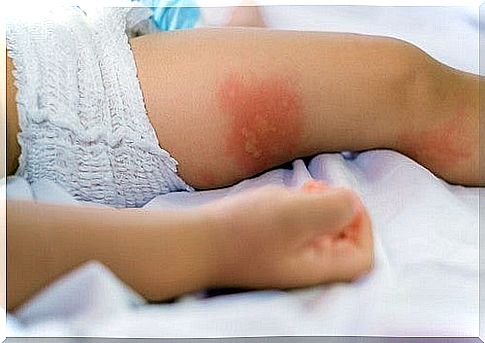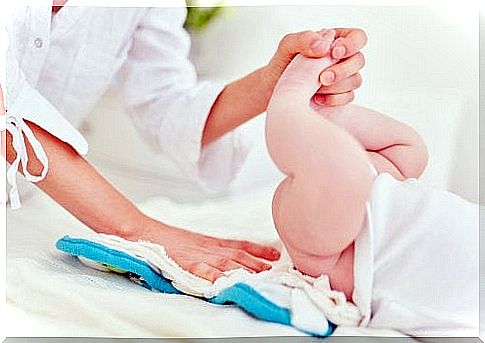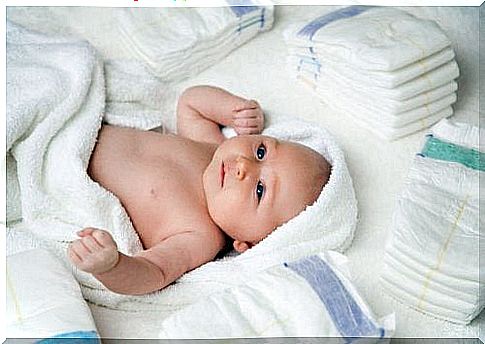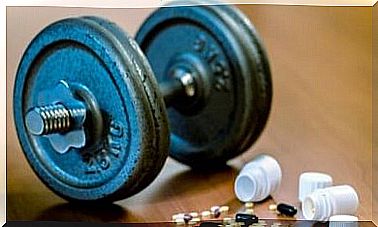How To Treat Diaper Rash

Contact of the diaper with the baby’s skin usually causes very annoying inflammation such as diaper rash. It is a very normal situation for any newborn when he is wearing a diaper. Later, we will know everything you need about diaper rash.
Babies’ skin is very sensitive and delicate. Many parents find it difficult to treat diaper rash as it is always covered. What to do in these cases?
Between 4 and 16 months, babies can suffer from diaper rash. In many cases this has to do with contact with urine and feces. Especially when infants begin to ingest solid food and contact with feces is more irritating.
In case of diarrhea, even if we change the diaper as soon as possible, the brief contact with the delicate skin can cause dermatitis and other irritations.
How to recognize diaper rash
In practice, it is not difficult to recognize a case of diaper rash. This can be done by simply touching the buttock area of babies, or even observing it.
The affected area, especially the one in contact with the edges of the diaper, has a rash, red spots or simply a dark pink irritation.
Although this is a problem that can be solved at home, it is advisable to consult a pediatrician or child dermatologist.
On the other hand, it can also happen that, in advanced states or if the newborn scratches very hard, the irritation becomes a wound allowing access to fungi or bacteria. In these cases the infection must be treated before treating diaper rash in a timely manner.

How to treat diaper rash
The first step in the treatment is to wash with warm water and mild soap at each diaper change. Glycerin soaps should be avoided, as this component can affect the pH of the newborn’s skin.
Cleansing oils and lotions are not recommended as a substitute for washing. Use lukewarm water whenever you can. Place the baby near the water, take some liquid with your hands and drop it gently on the affected area.
The next step is to dry. It must be done very gently, preferably with cotton fabrics and with slow movements. The ideal is to let the baby breathe a little, without immediately putting on the diaper again.
Many parents feel phobia that the newborn may wet or dirty the bed. Even if those minutes of freedom for the body are of great happiness and relief for newborns, hygiene care is always important.
When the skin is dry, apply the ointment, conditioner or cream of your choice for the treatment of diaper rash. There are many traditional products and specific creams to moisturize and nourish the skin of the diaper area.
It should be remembered that, often, these creams can cause the opposite effect. Depending on the baby’s skin type, some chemicals such as zinc oxide can be unfavorable.
Other home remedies
A great alternative is to use natural products and home remedies. Among the former is rice powder, which helps reduce inflammation. Even the cream of marigold and oat have interesting anti-inflammatory properties.
When bathing the baby, cloth bags with soluble oats can be placed in water. Another option is to make tablets with this ingredient and place them in a more practical, convenient and simple way on the affected area.

The last step in the treatment is to remember that when putting on the diaper, it should not be too tight. This way we let the air through. Parents who wait too long before changing their nappies should know that this increases the likelihood of getting annoying nappy rash.
For their part, nursing mothers have a great advantage in the treatment of diaper rash. Just apply your own milk to the affected area of the baby. This is because breast milk has several substances that cure many of the baby’s ills.
In short, the important thing to avoid irritation is to change diapers regularly, wash carefully and use a product that keeps the skin protected throughout the day. With these simple care, your baby will be happy, radiant and will not have any discomfort.









